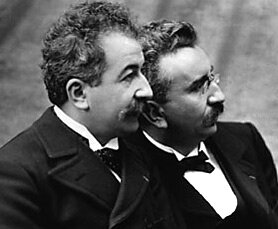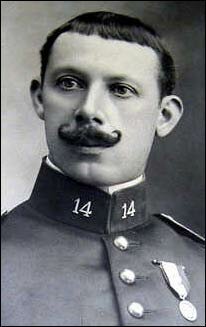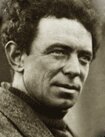North-African Soldiers cooking their meal in a village in Oise, France, 1917
(Autochrome color picture by Jean-Baptiste Tournassoud)
Above you see one of the few real color photographs of the First World War: a group of Spahis, Algerian soldiers, who fought with the French on the European battlefields.
 This beautiful picture was made by Jean-Baptiste Tournassoud, Chief of the Photography and Cinematography Organization of the French Army.
This beautiful picture was made by Jean-Baptiste Tournassoud, Chief of the Photography and Cinematography Organization of the French Army.
Tournassoud used a new technique, invented by Auguste and Louis Lumière (PICTURE LEFT), forerunners in photography and movies.
The first experiments with color photography were carried out in 1904 near Lyon in France, where father Lumière owned a photographic factory. In 1907 the Lumière brothers patented the autochrome process they had invented.
The picture of the Algerians above was made with such an autochrome plate. Microscopic grains of potato starch were dyed red, green, and blue-violet, then mixed evenly and coated onto a sheet of glass. A black-and-white emulsion was then flowed over this layer.
During exposure, the grains of potato starch on each plate acted as millions of tiny filters. The light-sensitive emulsion was then reversal processed into a positive transparency.
 When viewed, light passes through the emulsion and is filtered to the proper color by the starch grains. The resulting mosaic of glowing dots on glass gives autochromes the look of pointillist paintings.
When viewed, light passes through the emulsion and is filtered to the proper color by the starch grains. The resulting mosaic of glowing dots on glass gives autochromes the look of pointillist paintings.
Autochromes were the first true color pictures, and the only industrial color photography process until 1935. Commander Jean-Baptiste Tournassoud (picture on the right) and his photographers used this technique to record the circumstances under which the poilu's lived and fought.
You will find many of these French autochromes on page 6, on page 7, on page 8 and on page 9 of this article (some others are scattered over the other pages).
Paget Plates and digichromatography
 Another system, also used in that juncture, although on a much smaller scale, was the Paget Plate, invented in 1913: a color effect was achieved by looking at a black-and-white positive through a raster of colored lines.
Another system, also used in that juncture, although on a much smaller scale, was the Paget Plate, invented in 1913: a color effect was achieved by looking at a black-and-white positive through a raster of colored lines.
The Australian War Memorial has a small collection of these Pagets taken by the famous photographer Frank Hurley (PICTURE LEFT) who worked during the Great War in France and Palestine.
Color pictures made by Hurley and by his fellow-photographer Hubert Wilkens were in the splendid Captured in colour exhibition that toured Australia in 2004 and 2005. Some of their color pictures are shown on the next pages (we also have 50 black & white war pictures by Frank Hurley).
There were more color-systems, all of them obsolete now. The Russian photographer Sergei Mikhailovich Prokudin-Gorskii invented digichromatography, an astonishing three-color seperation system (one glass plate negative, three frames).
Prokudin-Gorskii travelled from 1905 until 1915 all over Russia and photographed prisoners-of-war, trains and lots of landscapes. We have some of his pictures here.
America
In the beginning of the century the Americans also experimented with color photography. Extraordinary war pictures shown here stem from a rare souvenir album, that was printed during the war by the Osborne Company from Newark N.J.
The pictures in this album were made by the Brown Bros. photographers, or by anonymous photographers employed by the American Press Association or by Underwood & Underwood.
Because the USA were still neutral in the beginning of the war the photographers of these agencies were initially able to work on either side of the front. The (handcolored) pictures from the Osborne album are published here for the very first time on the Internet.
Artificially tinted pictures of the American forces (army and navy) in the Great War can be found on Page 4 of this article.
Postcards
Color postcards from the Great War are always black-and-whites that were hand tinted afterwards. Check out our page with romantic color postcards from the war.
If you click here you get a large slide show with alternately true color pictures (autochromes and Pagets and digichromats) and artificially colored pictures. You can also choose from the thumbnails below and click on them.
There are 9 of these thumbnail pages, numbering altogether 250 color pictures. Take your time!
![]()
![]() Choose a page: 0 - 1 - 2 - 3 - 4 - 5 - 6 - 7 - 8 - 9
Choose a page: 0 - 1 - 2 - 3 - 4 - 5 - 6 - 7 - 8 - 9
![]() Or go back to the frontpage of The Heritage of the Great War.
Or go back to the frontpage of The Heritage of the Great War.